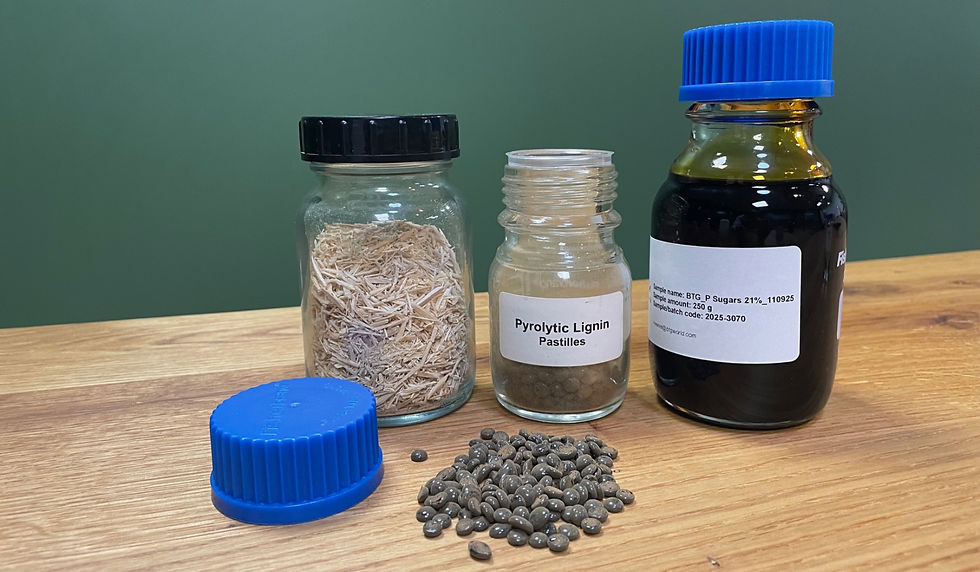Exploring High-Quality Pyrolytic Lignin Production Techniques
- hansbevers3
- Oct 14
- 4 min read
Updated: 7 days ago
In recent years, the demand for bio-based raw materials has surged. One of the most promising candidates in this field is pyrolytic lignin. This versatile substance, derived from biomass, has numerous applications in various industries. In this blog post, we will explore high-quality pyrolytic lignin production techniques, highlighting their importance and effectiveness.
Pyrolytic lignin is produced through the a combined pyrolysis and fractionation process, which involves heating organic material in the absence of oxygen. This method breaks down the biomass into smaller molecules, resulting in a complex mixture of organic compounds. Understanding the production techniques is crucial for maximizing the quality and yield of lignin.
What is Pyrolysis and Fractionation?
Pyrolysis and in particular fast pyrolysis is a thermal decomposition process that occurs in the absence of oxygen. It transforms biomass into fast pyrolysis bio-oil.
Fractionation is the separation of fast pyrolysis bio-oil into its main components; pyrolytic lignin, pyrolytic sugars and phenolics.
The focus of this blog post is on the production of pyrolytic lignin.
The Importance of High-Quality Lignin
High-quality lignin has several advantages. It can serve as a renewable alternative to synthetic materials. Here are some key benefits:
Sustainability: Lignin is derived from renewable biomass sources, making it an eco-friendly option.
Versatility: It can be used in various applications, including adhesives, coatings, and even as a carbon source in batteries.
Cost-Effectiveness: Producing lignin from waste biomass can reduce costs and promote a circular economy.
To harness these benefits, it is essential to focus on high-quality production techniques.
Key Techniques for Producing High-Quality Pyrolytic Lignin
Several techniques can enhance the quality of pyrolytic lignin. Here are some of the most effective methods:
1. Feedstock Selection
The type of biomass used as feedstock significantly impacts the quality of lignin produced. Different feedstocks yield different lignin properties.
Hardwoods: Generally produce higher quality lignin due to their higher lignin content.
Softwoods: May yield lower quality lignin but are more abundant and cost-effective.
Agricultural Residues: Such as straw or corn stover, can also be used, but their lignin quality may vary.
Choosing the right feedstock is the first step toward producing high-quality lignin.
2. Pyrolysis Temperature
The temperature at which pyrolysis occurs plays a crucial role in lignin quality.
Low Temperatures (300-500°C): Favor the production of bio-oil with higher lignin content.
High Temperatures (500-800°C): Lead to more extensive decomposition, resulting in lower lignin yields.
Finding the optimal temperature is essential for maximizing lignin quality.
3. Heating Rate
The rate at which the biomass is heated can also affect lignin production.
Fast Pyrolysis: Involves rapid heating, which can produce higher yields of bio-oil and lignin.
Slow Pyrolysis: Allows for more complete decomposition, but may result in lower lignin yields.
Adjusting the heating rate can help optimize lignin production.
4. Residence Time
The amount of time the biomass spends in the pyrolysis reactor is another critical factor.
Short Residence Time: Can lead to higher yields of bio-oil and lignin.
Long Residence Time: May result in more complete decomposition, reducing lignin yields.
Balancing residence time is key to achieving high-quality lignin.
Challenges in Pyrolytic Lignin Production
While there are many techniques to enhance lignin quality, several challenges remain.
Variability in Feedstock: Different biomass sources can lead to inconsistent lignin quality.
Complexity of Lignin Structure: The complex nature of lignin makes it difficult to characterize and utilize effectively.
Economic Viability: The cost of production can be high, making it challenging to compete with conventional materials.
Addressing these challenges is essential for the successful commercialization of pyrolytic lignin.
Real-World Applications of Pyrolytic Lignin
The versatility of pyrolytic lignin allows for various applications across different industries. Here are some notable examples:
1. Biofuels
Lignin can be converted into biofuels, providing a renewable energy source.
Lignin-Based Fuels: Can be used in transportation and heating applications.
2. Bioplastics
Lignin can serve as a biopolymer in the production of biodegradable plastics.
Sustainable Packaging: Lignin-based plastics can reduce reliance on fossil fuels.
3. Adhesives and Coatings
Lignin's adhesive properties make it suitable for use in various coatings and adhesives.
Eco-Friendly Adhesives: Lignin-based adhesives can replace synthetic options, reducing environmental impact.
4. Carbon Materials
Lignin can be used to produce carbon materials for batteries and other applications.
Energy Storage: Lignin-derived carbon can enhance the performance of batteries.
These applications highlight the potential of pyrolytic lignin in creating sustainable solutions.
The Road Ahead for Pyrolytic Lignin
As the world moves toward more sustainable practices, the importance of pyrolytic lignin cannot be overstated.
Innovation: Continued research and development will drive improvements in production techniques.
Collaboration: Partnerships between academia, industry, and government can foster advancements in lignin applications.
Awareness: Educating stakeholders about the benefits of lignin can promote its adoption.
By focusing on high-quality production techniques, we can unlock the full potential of pyrolytic lignin.

In summary, exploring high-quality pyrolytic lignin production techniques is essential for harnessing its potential. By understanding the key factors that influence lignin quality, we can develop more effective and sustainable production methods. The future of pyrolytic lignin looks promising, and with continued innovation, it can play a significant role in creating a more sustainable world.





Comments